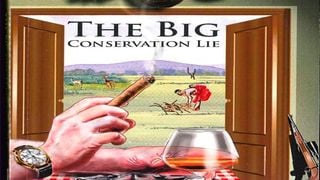Breaking News: At least 10 feared to have drowned in Makueni river

The cover of the book 'The Big Conservation Lie' by John Mbaria and Mordecai Ogada.
| FileNews
Premium
Book casts doubt on Leakey's legacy as conservationist
Richard Leakey, who died yesterday aged 77, was a globally celebrated conservation hero but just like his widely acclaimed legacy his life was not without controversy.
His dark side is revealed in the book The Big Conservation Lie co-authored by journalist and planner John Mbaria, who for years investigated and wrote about wildlife conservation, and Dr Mordecai Oganda, a carnivore ecologist with two decades in wildlife conservation work in Kenya and other parts of Africa.
The book exposes the rot in wildlife conservation in Kenya and sheds light on the decades-long hero worship of white settlers, who it says are lionised for taking to a life of selfless service to the wilderness and its residents.
“Though they serve in environments where native Africans have lived for centuries and have done little or more than simply live among animals, they have continued to receive near-universal adulation,” the book notes.
One such conservationist was Leakey, who is famed for discovering a near-complete Homo erectus skeleton that was named the Turkana Boy near the shores of Lake Turkana despite having no archaeological training.
The book describes him as a high school dropout who enjoyed a long managing career at the Kenya Wildlife Service (KWS) twice as head in the 1990s, as an assistant chairperson to the board of trustees and eventually as chair of that board.
It questions Leakey’s near-unanimous adulation in the West that the book largely attributes to unschooled and ununiformed perceptions.
Though it acknowledges that Leakey may have waged a personal anti-poaching initiative for which he paid dearly, the book claims his legacy has escaped rigorous scrutiny that reveals the old man as part of a “small cabal of exclusively white conservationists and thinkers” that is behind the mess in wildlife conservation in Kenya.
Became a shriek
“The global adulation of Leakey’s layman entry into the world of wildlife conservation and his largely self-perceived gigantic role in saving species is based largely on misinformation and a lack of information.”
Praise for Leakey, however, became a shriek shortly after he was involved in a plane accident in 1993 that was allegedly organised by his sworn enemies in the Moi government.

Conservationist and former Head of Public Service Richard Leakey who died on January 2, 2022.
The book says Leakey’s reliance on guns and boots to “drive conservation” has hardly been questioned and his decision to give his brother Jonathan a long-running permit to strip Kenyan forests of the highly lucrative bark of the Prunus Africana tree is a subject that no one dares delve into.
“This conspiracy of silence has pervaded, leaving the evaluation of why and how the KWS has floundered ever since Leakey sat at its helm in the 1990s, or twice on its board and influenced operations from without, to people seen more as spoilsports or macabre detractors of a living conservation messiah.”
Though the long history of Kenya’s wildlife crimes is full of locals, a “few” past sting operations linked poaching activities to settlers, particularly a 2013 ivory case.
The following year, KWS boss William Kibet Kiprono, speaking at a wheelbarrow race at Hell’s Gate National Park in Naivasha, accused some conservancies of collaborating with poachers to kill wild animals and said they were risking being degazetted.
“We have enough proof that some of the poachers are being aided by the so-called conservationists. In fact, some even provide the poachers with powerful weapons to kill wild animals. The same conservationists then use photos of the dead rhinos and elephants to solicit funds globally to fight poaching in Kenya,” a Nation story quoted him saying.
The book says Leakey’s close friend Charles Njonjo, who died hours before him at his residence in Muthaiga, Nairobi, on Sunday, also had a questionable stint at KWS.
After falling out with President Daniel Moi over an alleged plot to overthrow him, Moi initiated a long, widely publicised inquest against him before pardoning him and awarding him an appointment as KWS chairman.
Global fan base
Njonjo, the book claims, godfathered a small clique of state officials that operated in a less crude manner but captured portions of the wildlife sector for its own interests.
Leakey may have managed to convince an adoring global fan base that his two terms at the KWS were full of achievements, the book argues, but his weakness as a manager and transgressions as a conservationist abound.
Mr Mbaria notes that Leakey’s death may put a stop to his secret dealings but the problem persists.
“It’s a systemic problem. Leakey was just a kingpin of this deceitful conservation lot and co-opted top leaders in the country. The problem may end if communities decide to put up a fight but for now, the status quo remains,” Mr Mbaria told the Nation yesterday.
In the epilogue, the authors say they wrote the book to expose the rot and lies that cloud conservation efforts in Kenya.
“The story shares documented evidence of what goes on in the Kenyan conservation world collected by me during my times as a journalist within East Africa and my co-author, who was then a director at the Laikipia Wildlife Forum. It would be tragic if one read it and remained indifferent,” Mr Mbaria noted yesterday.
The authors say publishing their findings was not easy. Seven local publishers declined to touch the book, prompting them to find one in the United States.
“We went to seven publishers and they refused because of inherited colonial trauma, the thought that in this country you can criticise a president but not a white settler. We did the unthinkable and published the book,” Mr Mbaria said.
Even after publishing it, major bookstores in Kenya refused to stock it until it became popular and one store even shipped copies from the US publisher.





